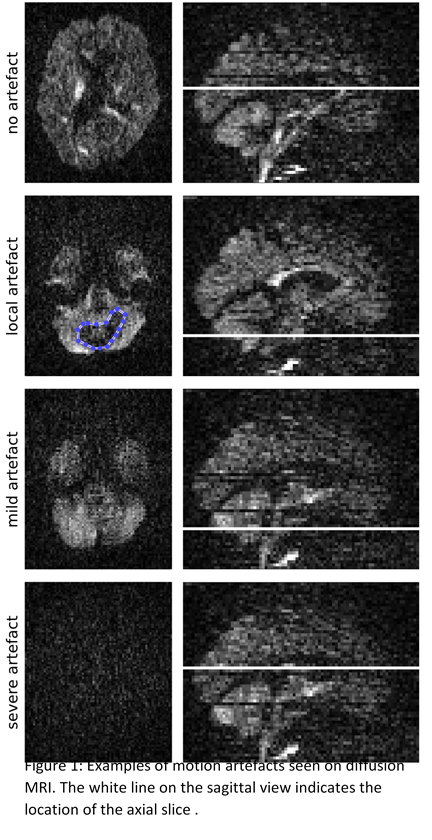Diffusion MRI motion artefacts
Motivation: Diffusion Magnetic Resonance Imaging (MRI) can provide valuable insight into microstructural properties of the brain white matter in health and disease. However, obtaining high-quality diffusion MRI data is challenging because of relatively long acquisition times and the patients’ inability to remain still for this length of time. Diffusion MRI data is particularly prone to artefacts caused by motion due to head movement and cardiac pulsation. These artefacts need to be detected and corrected to provide accurate measures of microstructure.
Outline: In this project, new methods for the detection and correction of motion-related artefacts in diffusion MRI will be developed. A number of algorithms are already available; however their sensitivity and specificity requires further improvement. Using a deep learning approach for this problem may yield superior results.
A large dataset has already been labelled for presence or absence of motion artefact (see Figure 1), and is available for use in this project. This dataset includes diffusion MRIs across a wide age range, from preterm-born infants scanned at 30 weeks postmenstrual age to healthy elderly adults. Labelling by an additional observer is still required to allow assessment of inter-rater reliability of the labelling on this dataset.
In this project, new methods for the identification of motion artefacts will be trained and tested on this dataset. Deep learning methods will be compared to existing methods using hand-crafted features.
In addition to detection of artefacts, their correction is essential. This project will evaluate the effect of existing correction strategies on standard diffusion tensor measures (e.g. fractional anisotropy), and fibre orientations and amplitudes estimated using constrained spherical deconvolution.
Recent advances in the acquisition of diffusion data have led to a significant reduction in acquisition times via the “simultaneous multi-slice” (SMS) technique, also known as “multi-band”. The impact of head motion during a SMS diffusion acquisition requires further investigation, with further refinement of detection methods. Additionally, advanced diffusion models (e.g. Neurite Orientation Dispersion and Density Imaging, NODDI) have been introduced, which allow more detailed insights into brain microstructure. These advanced models require so-called multi-shell diffusion data. Detection of motion artefacts, and their effect on microstructural measures are still largely unexplored.
Data and methods: We have acquired multi-shell diffusion data in preterm-born infants scanned at 30 and 40 weeks postmenstrual age; and SMS-multi-shell diffusion data in children with cerebral palsy scanned at 8-10 years age. These datasets are ideally suited for training and testing of new detection and correction strategies.
The methods developed during this project will be integrated into the existing diffusion workflows, which are used across a number of different projects.
Skills required: The scope of this project can be adjusted to last approximately 12-18 months, and would be suited to a Masters student. Ideally the student will have a background in Computer Science, Engineering, Mathematics, or similar, and have expertise in C++, Matlab, and Python.
The student will join an internationally recognized team of researchers in the area of medical image processing. As such they will gain exposure to the clinical and research environments and build their experience in designing and developing a large and complex tool.
If you are interested in this topic and you are looking for further information, please contact me: email d3.fontanarosa@qut.edu.au, ph. 0403862724.
Check my START database entries: START
Expected output:
- A thesis
- 1-3 journal papers, depending on time-frame and scope
- A robust software package for detection and correction of motion artefacts on diffusion MRI
Other Team Members
